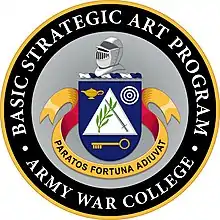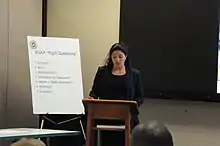Basic Strategic Art Program
The Basic Strategic Art Program (BSAP) is an academic program taught at the U.S. Army War College at Carlisle Barracks, Pennsylvania. The course was designed to support the educational requirements for Functional Area FA59 (FA59), U.S. Army Strategist, formerly called Strategic Plans & Policy. The first course began in 2003 and the school continues to teach three 16-week courses per year.
| Basic Strategic Art Program | |
|---|---|
 BSAP Crest | |
| Location | |
Carlisle, PA United States | |
| Information | |
| Established | 2003 |
| Authority | United States Army War College |
| Head teacher | Colonel Francis Park |
| Website | https://ssl.armywarcollege.edu/dmspo/index.cfm |
The course provides most new Army Strategists, who transition from a different U.S. Army basic branch, with a foundation in strategic theory and practice. It helps officers connect their early tactical experiences with the challenges of operating in the strategic environment. The course, which includes various staff rides and modules, is taught to rigorous academic standards. Failure to achieve these standards is cause for disenrollment from the program and removal from the functional area.
Origins
In September 2001, Army leaders in coordination with various senior service colleges such as the Army War College and National Defense University "convened a workshop to determine the competencies and educational requirements for Army strategists".[1] The attendees identified the functional area's "skills, knowledge, and attributes" and designed the resulting BSAP course to support them.[1]
On 16 January 2002, the Army G3 directed the Commandant of the Army War College to develop a basic qualification course for functional area 59; the G3 approved the BSAP concept on 22 July 2002. The pilot course was conducted 16 June through 17 September 2003.
The course began with seven-students in 2003 but by 2008 had grown to three 15-student classes.[1] Its first civilian interagency graduate in 2009 marked an effort to diversify the course.[1]
A 2010 analysis by the BSAP Director at the time, LTC Charles P. Moore, noted that U.S. Army strategists, in a relatively new career field at the time, had dissimilar experiences and a "degraded sense of identity and commonality" because not all new 59s were able to attend BSAP.[2] Moore stated that, "In time, all strategists will share a common BSAP experience, strengthening their commonality and collective identity" although noting that BSAP cannot accomplish the latter alone.[1]
Purpose
According to the U.S. Army War College's Department of Military Strategy, Planning, and Operations,
BSAP educates officers and Department of Army Civilians and graduates them equipped with the tools and perspective to bridge the gap between their tactical/operational background and the challenges of operating at the grand-strategic and theater-strategic level of war and policy. Moreover, the graduation completes most officers' transition from their basic branches to the Functional Area 59, Army Strategists.[3]
Curriculum

Faculty from across the U.S. Army War College support BSAP which also draws from "world class academic and professional guest speakers and lecturers".[3] There are three 16-week courses annually (Jan–Apr, May–Aug, and Sep–Dec).[3] The course includes various staff rides or visits including a trip to Washington D.C. to visit U.S. government interagency organizations and a staff ride of U.S. Grant's 1864 Overland Campaign at the conclusion of the course.[4] Students share experiences with those of the Advanced Strategic Arts Program, the U.S. Army War College resident program, and other Senior Service Colleges.[3]
As of 2010, the BSAP curriculum comprised the following six modules: "strategic theory, strategic art, joint and Army systems, national security decision-making, contemporary security challenges, and joint and Army planning".[1] The program uses the graduate seminar method.[1] It comprises "history, theory, exercises, guest lectures, and staff rides ... to develop a 'rich professional perspective on policy, strategy, and doctrine'".[1]
Modules
The first BSAP module is Strategic Theory which allows students to "evaluate doctrine and strategy". Students consider military classics by authors such as Sun Tzu and Clausewitz. The course also considers modern strategic theory related to service and joint doctrine as well as strategic culture and practical application of theory.[4] In the Strategic Art module, students study campaigns including the Peloponnesian Wars and Global War on Terrorism. Topics of discussion include: "strategy and policy match, theories of victory, mirror imaging, civil-military relations, pre-war plans and wartime realities, and coalition warfare".[4] The National Security and Decision-making module focuses on decision-making and organization within the executive branch of the U.S. government, including real-world case studies and a trip to Washington D.C. for U.S. government interagency visits including the Central Intelligence Agency, National Security Council, State Department, and others.[4] In the Contemporary Strategic Challenges module, students learn about homeland security as well as conduct regional studies related to Northeast Asia, Southwest Asia, Western Hemisphere, and Europe.[4] The Institutional Strategy and Planning module centers on the U.S. Army related to resources, force management, readiness, and transformation.[4] In the Joint and Army Planning module, students learn about campaign planning with U.S. Army forces and landpower in a broader strategic context.[4]
Reading List
- 2006 Lebanon Campaign and the Future of Warfare: Implications for Army and Defense Policy, Stephen Biddle and Jeffrey Friedman
- 34 Days: Israel, Hezbollah and the War in Lebanon, Amos Harel and Avi Issacharoff
- Accidental Guerilla: Fighting Small Wars in the Midst of a Big One, David Kilcullen
- American Civil - Military Relations, Edited by Suzanne C. Nielsen and Don M. Snider
- American Politics: Classic and Contemporary Readings, Allan C. Cigler
- American Way of War, Russell F. Weigley
- An Unknown Future and A Doubtful Present, Writing the Victory Plan of 1941, Charles E. Kirkpatrick
- And Keep Moving On, Mark Grimsley
- Art of War by Sun Tzu, trans. by Samuel Griffith
- Asking the Right Questions: A Guide to Critical Thinking, M Neil Browne and Stuart Keeley
- Austro-Prussian War, Geoffrey Wawro
- Bombing to Win: Air Power and Coercion in War, Robert A. Pape
- Bureaucracy: What Government Agencies Do and Why They Do It, James Q. Wilson
- Carrying the War to the Enemy: American Operational Art to 1945, Michael R. Matheny
- Cobra II, Michael Gordon and Bernard Trainor
- Congress: The Electoral Connection, David Mayhew
- Centers of Gravity and Critical Vulnerabilities, Perspectives on Warfighting, Dr. Joe Strange
- Confederate War, Gary W. Gallagher
- Conflict After the Cold War, Richard K. Betts
- Counterinsurgency in Modern Warfare, Daniel Marston and Carter Malkasian
- Dereliction of Duty, H.R. McMaster
- Elements of Style, William Strunk and E.B. White
- Essence of Decision: Explaining the Cuban Missile Crisis, Graham T. Allison and Philip Zelikow
- Fighting Talk: Forty Maxims on War, Peace, and Strategy, Colin S. Gray
- Franco-Prussian War: The German Conquest of France in 1870–1871, Geoffery Wawro
- Grand Strategies in War and Peace edited by Paul Kennedy
- Grand Strategy of the Roman Empire, Edward N. Luttwak
- Great Civil War: A Military and Political History 1861–1865, Russell F. Weigley
- Landmark Thucydides R.B. Stassler
- The Lexus and the Olive Tree, Thomas L. Friedman
- Making of Peace: Rulers, States, and the Aftermath of War, Williamson Murray
- Making of Strategy: Rulers, States, and War, Williamson Murray, MacGregor Knox, Alvin Bernstein
- Modern Strategy, Colin S. Gray
- Obama's Wars, Bob Woodward
- On Point: US Army in Operation Iraqi Freedom, Gregory Fontenot, E.J. Degen, David Tohn
- On Point II : the United States Army in Operation Iraqi Freedom, May 2003 – Jan 2005 : Transition to the New Campaign, Donald P. Wright
- On War, Clausewitz
- Paths of Heaven, Evolution of Airpower Theory, Phillip S. Meilinger
- Patterns of War Since the Eighteenth Century, Larry H. Addington
- Peace to End all Peace: The Fall of the Ottoman Empire and the Creation of the Modern Middle East, David Fromkin
- Plan of Attack, Bob Woodward
- Selected Military Writings of Mao Tse-Tung, Mao Tse-tung
- Spanish Ulcer: A History of the Peninsular War, David Gates
- Strategy and Power in Russia 1600–1914, William C. Fuller, Jr.
- Strategy in the Contemporary World, John Baylis, James Wirtz, Eliot Cohen, Colin Gray
- Supreme Command, Eliot A. Cohen
- Thinking in Time: The Uses of History for Decisionmakers, Neustadt and May
- This Mighty Scourge: Perspectives on the Civil War, James McPherson
- The Endgame: The Inside Story of the Struggles for Iraq, from George Bush to Barack Obama, Gordon and Trainor
- The Tragedy of Great Power Politics, John Mearsheimer
- Transformation of War, Martin Van Creveld
- Transforming an Army at War: Designing the Modular Force, 1993–2005, William M. Donnelly
- War, Peace and International Relations: An Introduction to Strategic History, Colin S. Gray
- War Within: A Secret White House History 2006–2008, Bob Woodward
- Why the Allies Won, Richard J. Overy
References
- Charles P. Moore (Winter 2009–10). "What's the Matter with Being a Strategist (Now)?". Parameters. Vol. 39, no. 4. Carlisle, PA: U.S. Army War College. p. 11. Retrieved August 6, 2021.
- Charles P. Moore (Winter 2009–10). "What's the Matter with Being a Strategist (Now)?". Parameters. Vol. 39, no. 4. Carlisle, PA: U.S. Army War College. pp. 6, 11. Retrieved August 6, 2021.
- "Basic Strategic Art Program". Department of Military Strategy, Planning, and Operations. Army War College. Retrieved August 6, 2021.
- "Basic Strategic Art Program". United States Army War College. Archived from the original on 2007-06-25. Retrieved August 6, 2021.
Bibliography
- Basic Strategic Art Program
- The Strategic Plan and Policy Officer in the Modular Division -- Military Review
- What’s the Matter with Being a Strategist? -- Parameters
- What’s the Matter with Being a Strategist (Now)? -- Parameters